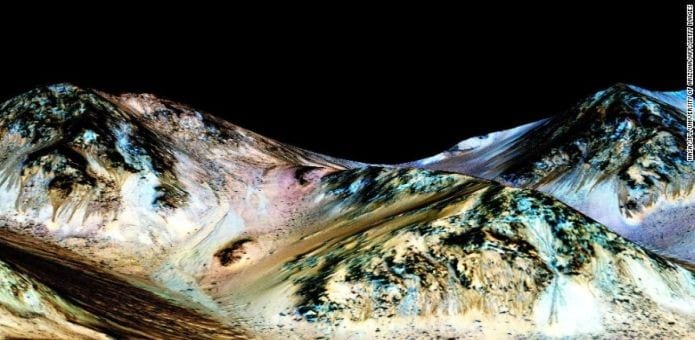NASA says strong evidence of both frozen and liquid water found on Mars
NASA revealed today liquid water has been found on the surface of Mars, changing the perception of Mars as a completely arid, desert-like planet, according to a study published in the journal Nature Geoscience. The finding also fuels speculation that life may have at one time thrived on Mars or could possibly even exist today.
This revelation comes from new spectral data gathered by NASA’s Mars Reconnaissance Orbiter (MRO), a spacecraft that studies the planet from orbit. The orbiter analyzed the chemistry of weird dark streaks that have been known to appear and disappear seasonally on the Martian surface. The analysis confirms that these streaks are formed by briny or salty water flowing downhill on Mars.
“We now know Mars was once a planet very much like Earth with warm salty seas and fresh water lakes,” Jim Green, planetary science director at NASA, said at a news conference. “But something has happened to Mars, it lost its water.”
In a paper published in the journal Nature Geoscience, Dr. McEwen and other scientists identified waterlogged molecules — salts of a type known as perchlorates — in readings from orbit.
“That’s a direct detection of water in the form of hydration of salts,” Dr. McEwen said. “There pretty much has to have been liquid water recently present to produce the hydrated salt.”
By “recently,” Dr. McEwen said he meant “days, something of that order.”
While today’s discovery is huge, it is small compared to the rivers, lakes and vast oceans that are believed to have flowed on Mars billions of years ago. Scientists have long known that large amounts of water remain — but frozen solid in the polar ice caps. There have been fleeting hints of recent liquid water, like fresh-looking gullies, but none have proved convincing.
Lujendra Ojha, a scientist at Georgia Tech who first spotted the lineae back in 2010 says planetary scientists hypothesized that the streaky formations were products of the flow of water, but they did not have solid, mineralogical proof for that idea until now. Ojha and his colleagues present “smoking gun validation” that it was liquid water flowing on Mars’ surface that formed these tear stains, in a new Nature Geoscience Paper published online today.
The lines are blackish and narrow at less than 16 feet across. During the warmer seasons, the streaks grow thicker and longer, and when Mars is colder, they then fade and shrink at times.
This led scientists to believe years ago that perhaps water and salt were involved in the creation of these lines. “[The streaks] loved forming at temperatures that were right for liquid water to exist,” says Ojha.
According to Ojha, they have not actually observed water flowing on Mars. The data was taken by the from the CRISM instrument on the MRO, which only observes the surface every day at 3 pm. That’s the time when Mars is at its driest and hottest, so any liquid water flowing on the surface would have long since evaporated by the time MRO laid eyes on it.
Still, the water left a distinctive chemical trace. “Whatever is flowing on Mars is hydrating the salt,” Ojha says, “and we’re seeing that hydration in the spectral signature.” The researchers studied the chemical makeup of the recurring slope lineae using the MRO’s imaging spectrometer. The visible-infrared spectrometer, which can determine the composition of minerals by observing them in different light wavelengths, showed that the dark streaks were indeed composed of hydrated salts that have molecular water in their crystal structure. “What that seems to be telling us is that water plays a key role in the formation mechanism of these features,” said Ojha.
As for where this water is coming from, the team doesn’t know where the water is coming from, or how much of it there is yet. “That’s the big mystery right now,” Ojha says. However, Ojha noted that there may three possible sources. The salt may be grabbing moisture out of the Martian atmosphere to create liquid water. It may be from a subsurface reservoir of ice that turns into liquid when it comes in contact with the salts. There’s even the possibility of an aquifer that is generating the water needed for the briny flows.
The discovery of water could also be a boon for a future manned mission to Mars since it would help astronauts lighten their load traveling to the Red Planet. Also, this is exciting evidence that Mars could potentially support life including human life provided it is able to figure out how to colonize the place.

